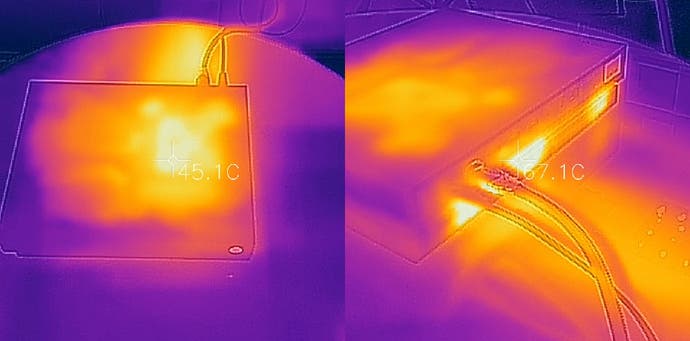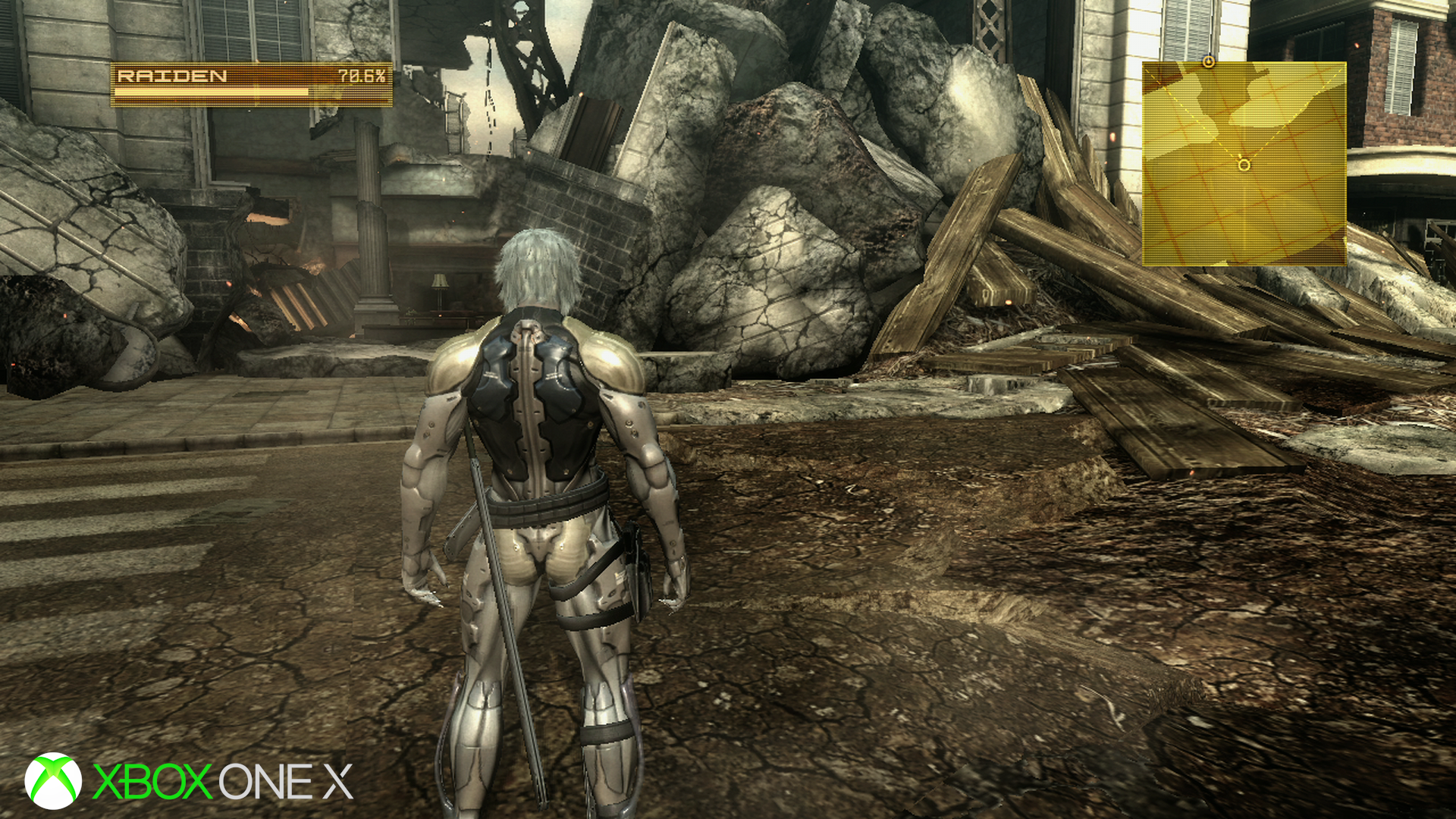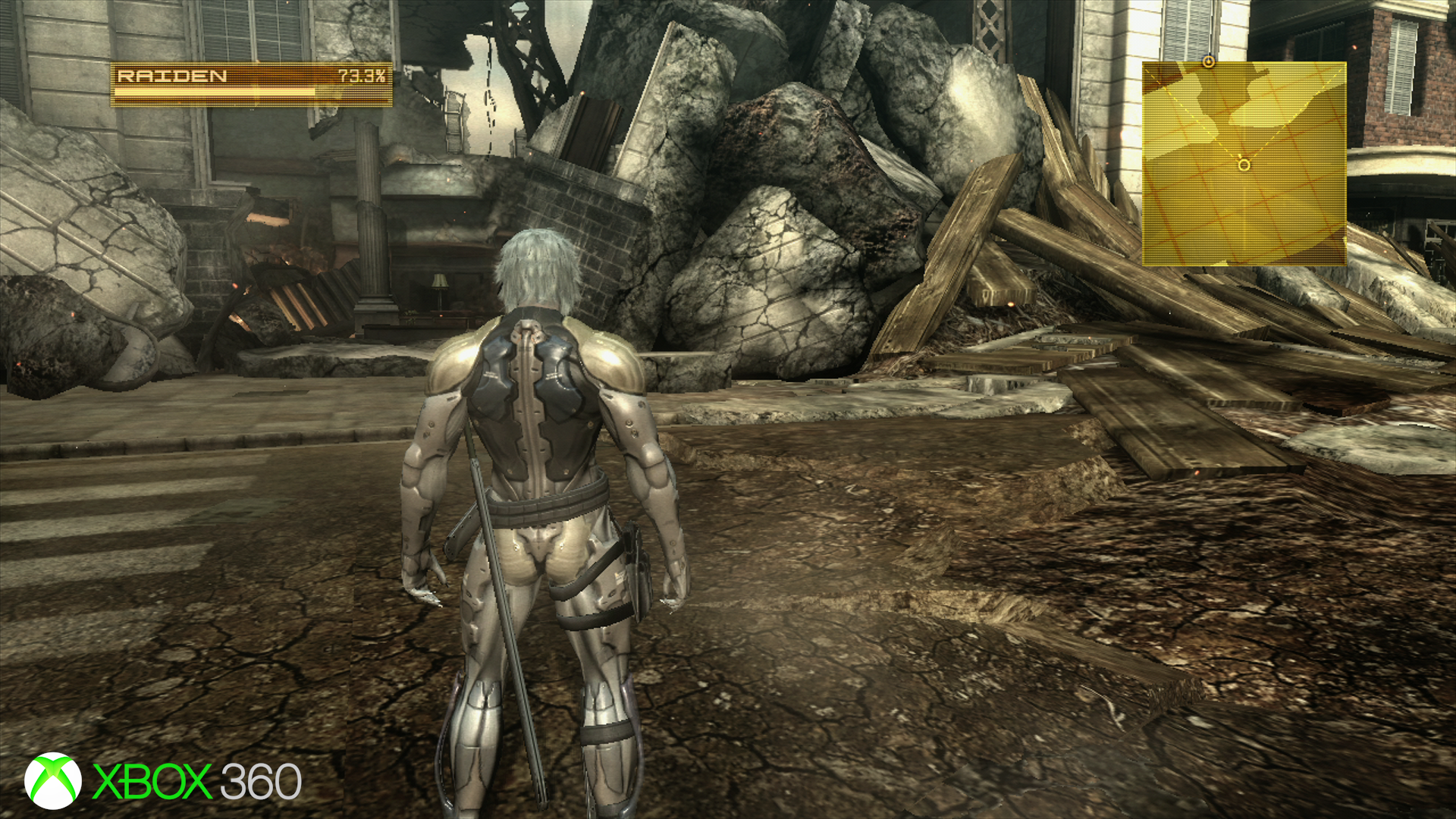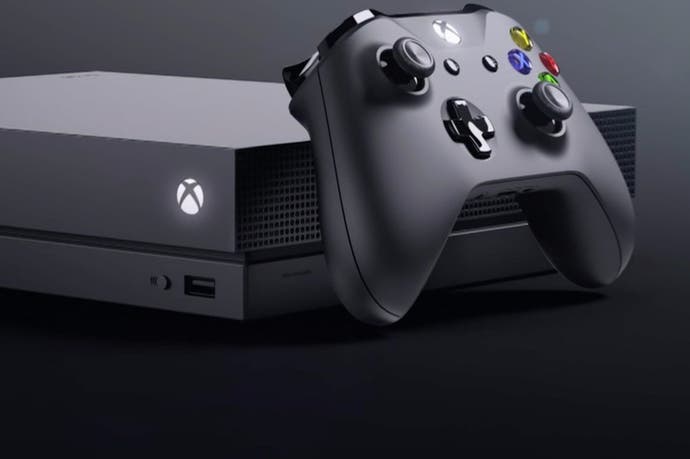Microsoft Xbox One X review
The Digital Foundry verdict.
One year on from the release of the PlayStation 4 Pro, the fortunes of Sony's 'supercharged' console have varied. While titles like Gran Turismo Sport and Horizon Zero Dawn have demonstrated just how well console titles can scale to 4K HDR displays, too many games are delivering lacklustre results that only offer a smaller, more incremental upgrade over the base PS4 experience. Now it's Microsoft's turn, with the new Xbox One X offering more of a brute force approach to tackling the 4K challenge.
The rationale behind the Xbox One X's hardware specification is simple: if ultra HD resolution uses four times as many pixels as standard 1080p, why not make the graphics hardware in the new box four times more powerful than the existing base console? And in a world where the PC versions of multi-platform titles can eat up eight gigs of VRAM owing to their higher resolution artwork aimed at 4K displays, why not bump up the memory provision of the new machine to a massive 12GB of GDDR5?
Is it a strategy that hands in more consistent results than we've seen over the last year on PlayStation 4 Pro? The early evidence looks positive but certainly in terms of the scope of this review, the jury is still out. While we've had a generous amount of time with the Xbox One X hardware, the fact is that high-profile X-enhanced titles available for us to test during the review period have been disappointingly thin on the ground. Gears of War 4 amounts to the only triple-A first party game we had any decent amount of time with, while third party titles have been slow to appear. On top of that, Microsoft's masterstroke in providing free 4K enhanced versions of Xbox 360 titles is another fascinating aspect of the offering we've barely had a chance to look at - Halo 3, Fallout 3 and Oblivion receiving updates just a couple of days away from the review embargo.
The upshot of this is that our hands-on experience of how existing titles scale up on the new hardware hasn't changed that much from the preview period, when we actually had access to more Xbox One X code and a larger range of key games. So, if you're coming to this review looking for a more definitive answer to the question of how PS4 Pro and Xbox One X compare, prepare for disappointment. Microsoft tells us that the paucity of properly X-enabled software will be resolved by the time the system launches on November 7th and to be fair, the volume of updates has certainly ramped up in the last couple of days.
| Xbox One X | Xbox One | PlayStation 4 | PS4 Pro | |
|---|---|---|---|---|
| CPU | Eight evolved AMD Jaguar x86 cores at 2.3GHz | Eight AMD Jaguar x86 cores at 1.75GHz | Eight AMD Jaguar x86 cores at 1.6GHz | Eight AMD Jaguar x86 cores at 2.1GHz |
| GPU | 40 customised compute units at 1172MHz | 12 GCN compute units at 853MHz (Xbox One S: 914MHz) | 18 GCN compute units at 800MHz | 36 'improved' GCB compute units at 911MHz |
| GPU Compute | 6.0TF | 1.31TF (Xbox One S: 1.4TF) | 1.84TF | 4.2TF |
| Memory | 12GB GDDR5 | 8GB DDR3/32MB ESRAM | 8GB GDDR5 | 8GB GDDR5 |
| Memory Bandwidth | 326GB/s | DDR3: 68GB/s, ESRAM at max 204GB/s (Xbox One S: 219GB/s) | 176GB/s | 218GB/s |
But that's not to say that we don't have much to talk about! Just unboxing the machine and checking out the final hardware is a mini-event in itself, as the build quality and design is on another level - exactly as we said when we first saw the console. The fact is that Xbox One X is indeed slightly smaller than the existing Xbox One S - a machine that was the physical embodiment of Microsoft's recommitment to the gamer after the disappointments of the 2013 model. The aesthetically-challenged set-top box model was jettisoned in favour of a more classic, console-like form-factor with a beautiful design, robust matte plastics, and proper buttons. It retained the discreet acoustics of the original model, but improved radically in all other areas. The new Xbox One X follows the same strategy to a tee and is all the better for it.
In terms of its physical make-up, the new console is ever-so-slightly smaller than the S, but very much of the same family. Externally at least, the machine retains the same design language as the S, the major point of differentiation - colour and the sheer weight of it aside - being the placement of the cooling vents. Xbox One X uses a far more sophisticated thermal solution: the standard heat sink and upward-facing axial fan of the older Xboxes is replaced with a vapour chamber and centrifugal fan. Cool air is scooped in from the sides, with a lot of hot air expelled from the back. Xbox One X worked fine for us within a media cabinet, but over the longer term, we think the hardware is best suited to resting on top, out in the open. We measured the console skin at a maximum of 45 degrees Celsius, with rear vent heat rising to a maximum of 68 Celsius - it really gets hot back there and we'd highly recommend proper ventilation.
Alongside the console, the standard Xbox One X package includes the usual accessories: a figure-eight power cable, and an HDMI cable that Microsoft reckons is one of the highest quality in the business (our 4K capture kit is very fussy about cable quality, and Microsoft's offering definitely delivers). Also included is the requisite joypad and a couple of AA batteries. There are few surprises here, though curiously, the textured underside grip on the S controller is absent on the new controller - and we miss it.
Hooking up Xbox One X to a 4K HDR display (we tested with a mid-range Panasonic DX750 and an LG OLED B6) and booting up Gears of War 4, what's immediately apparent is that, with our review unit at least, this console is eerily quiet. In the early days of Project Scorpio, debug units with developers ran with the fans at full blast, but the final retail unit has an audio profile on par with the Xbox One S, despite a big increase in power consumption and heat generation. We got the same results on a second Xbox One X we tested, and bearing in mind that we measured peak draw from the wall at 175W, the discreet nature of the console is exceptional.

| Xbox One X | Xbox One | Xbox One S | |
|---|---|---|---|
| Power Off 'Rest Mode' | 26W-39W | 15W-25W | 9W-16W |
| Idle Dashboard | 50W | 48W | 25W |
| Watching Blu-ray | 55W | 60W | 33W |
| Watching UHD Blu-ray | 61W | - | 40W |
| Doom 2016 | 131W | 110W | 70W |
| Gears of War 4 | 128W/175W | 110W | 70W |
We have a Project Scorpio Edition pre-order arriving on launch day, so if a shop-bought console acts any differently, we'll be sure to let you know - but based on the hardware we have in hand for review purposes, it seems that Microsoft's gambit in matching each console's mainboard with the precise power requirements of each individual Scorpio Engine processor has paid off. But by extension, not every piece of silicon is created equal - and we'll be interested to see if there is the variation found in PS4 Pro (we have two Sony machines, one of which is much, much louder than the other).
As an aside, it would be remiss of us not to mention that, as quiet as the console is under load, it's even more discreet when running in its various backwards compatibility modes. Running original Xbox One software, Xbox One X is as whisper-quiet as the original model - even if it's tackling titles like Battlefield 1 or Doom 2016, which deploy more of the Scorpio Engine's power to produce higher frame-rates while maxing out their dynamic resolution scalers.
Just how quietly Xbox One X operates is even more surprising considering its power draw. When idling on the dashboard, the machine is essentially on par with the original Xbox One in terms of the juice it pulls from the wall, a situation that extends to Blu-ray playback too. However, when powered down in Microsoft's equivalent to 'rest mode', Xbox One X can pull up to 50W - which is not insignificant [UPDATE: Microsoft has been in touch and says that the extra power draw here may be down to an update downloading in the background - we'll update when we've tested it]. 175W is the maximum we could extract from the machine when running the enhanced Gears of War 4 - however, we noted a far lower 128W in the game's 1080p60 performance mode. Running at full pelt, our Xbox One X only increases power draw by about 20W compared to PlayStation 4 Pro - not bad considering the gulf in power between them that the specs suggest.
By virtue of its smaller processor running on the current 16nm FinFET process from chip fabrication giant TSMC, Xbox One S is easily the most power-efficient Microsoft console on the market right now. As expected, the new X model - using the same fabrication node - is profligate in consumption by comparison, but the engineering required in making it as quiet as its companion console is simply extraordinary. Back in April, we said that this was console design taken to a new level - and the final hardware does not disappoint.
The new console also ranks highly in terms of its backward-compatible game support. Microsoft promised faster loading via the faster CPU, hard drive and RAM disk (Xbox One X's extra memory is used as a vast cache) along with improved performance, enforced v-sync, 16x anisotropic texture filtering and the ability to push games that utilise dynamic resolutions to their maximum pixel counts. In all areas, Microsoft has not disappointed.
In terms of loading times, we saw an extended Witcher 3 load drop from one minute 45 seconds to just 45 seconds - remarkably, Xbox One X shaved off an entire minute. A fast travel jump in the same game also saw loading times drop from 45 seconds on a base Xbox One to just 19 on Xbox One X. The same game also benefitted from an immensely improved visual presentation owing to two factors: that 16x texture filtering boost and fully utilising dynamic resolution scaling. In prior Witcher 3 testing, the title always seemed to resolve to 900p and we could never shift that pixel count - but even without its upcoming X-enhanced patch installed (we're still waiting for that), the new console delivered a locked 1080p.
The best example of how increased resolution via dynamic scaling and improved texture filtering can improve the look of a game comes via Halo 5. Known for its low-res imagery and blurry ground textures, Xbox One X radically transforms the look of the game. The irony here is that by the time you read this, an X-enhanced 4K patch will be available - but the fact is that even without it, it's a huge upgrade.
In terms of performance lifts, most games simply lock more closely to their target frame-rates, be it 30fps or 60fps. In some scenarios, the uplift is slight. A game like Grand Theft Auto 5 already locks to 1080p30 for most of its duration - Xbox One X simply irons out the few drops beneath. In other titles, it is more noticeable: screen-tearing in Batman Arkham Knight is gone, and the lurches and stutters when driving through Gotham at speed in the Batmobile are also completely resolved.












It's games with unlocked frame-rates that allow us to see just what this machine can do, though. Hitman, predictably, doesn't have its Xbox One X patch out at the time of testing, but in its standard form, you can run it with an unlocked frame-rate, where we saw up to an 80 per cent increase in performance. Oddworld New 'n' Tasty is a rare title to offer both a 30fps lock and unlocked frame-rate support. It's not quite locking to 60fps, but the largest delta between base and X performance is a creditable 70 per cent. Another cool test to try - the original on-disc code for Assassin's Creed Unity also has an unlocked frame-rate. On Xbox One X, the early stages of the game hit 50-60fps, temporarily transforming the game.
We say 'temporarily', because the weakness in Xbox One X's back-compat support is linked directly to the lowest spec bump offered by the new hardware - the 31 per cent bump to CPU clocks. Microsoft has tweaked AMD's Jaguar design (specifically by adding more cache), but fundamentally, the processor cores are the same, just running at 2.3GHz instead of the base 1.75GHz. What that means is that performance increases where the console is CPU-limited are less impressive, typically in the 20 to 30 per cent range - something we measured by taking both Hitman and Assassin's Creed Unity through their respective NPC-packed Paris stages.
Where Xbox One X works best with library titles is in how it tackles dynamic resolution scaling. This is the process of adjusting the pixel count of any given frame on the fly, reducing GPU load to keep frame-rates smoother. On these titles, Xbox One X showed enormous improvement over the same code running on base hardware. id software's excellent Doom 2016 reboot locks to 1080p and runs flawlessly at 60 frames per second, showing clear performance and image quality enhancements. It'll be interesting to see how the actual Xbox One X patch improves matters here. Battlefield 1 gains a similarly revelatory improvement, running flawlessly with an obviously higher pixel count.
Call of Duty Infinite Warfare is post-process-heavy and features a horizontal dynamic scaler. The improvement to image quality isn't immediately obvious, but the near constant performance drops and tearing found on original Xbox One hardware are completely gone. Also well worth checking out is the Final Fantasy 15 Platinum demo - a notoriously poor performer on both PS4 and Xbox One. Base hardware features a low resolution and some sub-20fps action - running the demo on Xbox One X sees the pixel-count hit a 1080p maximum and performance, while not perfect, is radically improved.










Microsoft's support for Xbox 360 is no less impressive - and you can feel the difference straight away with lightning fast loading speeds. We instantly put the hardware to the test by rolling out two of our favourite games - Metal Gear Rising: Revengeance and Bayonetta. Both aim for 60fps but fall well short on original hardware. There are clear advantages to running these games on the standard Xbox One, but neither lock to 60fps, still dropping frames in the most intense scenes. Xbox One X achieves a clean result here, offering the smoothest experience we've seen.
We also tested several Call of Duty titles, and again, frame-rates were locked, significantly improved over the already creditable Xbox One showings and a big improvement over the original model. The only exception to the rule came from Call of Duty 3, which still wobbles somewhat. Regardless, all titles showed significant improvements, and the hardware really delivers for users who've held onto their existing collections.
Pushing emulation to the limit here isn't easy, but we thought we'd roll out Grand Theft Auto 4 with its unlocked frame-rate to see what happens. Original Xbox 360 hardware varies dramatically from the low 20s to around 40fps. In our tests, Xbox One X handed in performance from 35fps in the busiest city scenes to a full-fat 60fps in many cutscenes and less complex areas. It's not exactly the way we'd want to play the game but the performance bump is noticeable.
Again, owing to the fact that code only dropped a couple of days ago, we didn't have much time to test one of Xbox One X's most impressive party tricks - the ability to run old games at 4K resolution. It's a great feature that's well worth experimenting with, the Microsoft back-compat team essentially hacking into the original game code and making improvements by enforcing higher resolutions and removing texture mip-map transitions, forcing the highest quality art to resolve across the scene. We carried out some initial tests on Oblivion (which initially resolved at 1024x600 on Xbox 360) and found that not only is there a big resolution bump, but performance is improved too. The gallery above demonstrates the enhancements and they are extraordinary.
But Xbox One X is a machine designed for the future, to perfectly complement a potential 4K display upgrade - and outside of the gaming arena, Microsoft has work to do. While the UHD Blu-ray drive is a feature that sets Xbox One X apart from PS4 Pro, elsewhere, the systems's 4K media playback functions do seem lacking. The onboard media player can't cope with the 4K media we produce for our video download site, digitalfoundry.net, and while Netflix does support both 4K and HDR, Amazon only ticks the ultra HD box, meaning that high dynamic range isn't available. Meanwhile, another rich source of 4K and HDR content - YouTube - is also served by a really poor app that provides neither.
The bottom line is that both the Panasonic and LG OLED displays we tested with Xbox One X support 4K media better than Microsoft's new console - and that's a shame, not to mention a real opportunity for the platform holder. While LG's WebOS front-end is a joy to use, we can't say the same for the Panasonic or Samsung front-ends, which the Xbox One X could replace with a far superior interface. To give Microsoft credit, the new dashboard is a massive improvement over prior efforts - fast, slick and responsive, it's logically designed and works beautifully.
The one fly in the ointment here is that if you run Xbox One X on a 4K screen, you're still getting a 1080p dashboard, upscaled - just as it is on the S model. When we visited Microsoft at the end of March, the original plan was to reserve 1GB of RAM for the upgraded ultra HD dashboard, leaving 8GB total for developers. Microsoft tells us that game-makers said that they could use the extra memory, so plans for the 4K front-end were dropped. GameDVR has been upgraded to support 4K media and this does still operate in ultra HD, but otherwise, all elements of the dash are a little bit blurry owing to the upscale. The bottom line? Xbox One X features nine gigs for games, with 3GB reserved for the system.
Of course, users of standard full HD displays won't be too upset by the 1080p dashboard - and we can confirm that of the limited X-enhanced 4K titles we played, they did indeed super-sample down to 1080p, offering exceptional anti-aliasing. It's a boon for sure, but running the X-enhanced Gears of War 4 on a 4K HDR display, the improvement to the experience is simply phenomenal. That's what the machine was built for, and that's where it shines. Clearly, there are benefits running Xbox One X on a full HD screen, but to be frank, it's nothing like the full-fat experience.
Microsoft Xbox One X: the Digital Foundry verdict
The workmanship that's gone into Microsoft's latest console is exceptional. To quadruple graphics power over the original model but to retain essentially the same form factor and the same acoustics points to a level of engineering that really does take console design to the next level. Xbox One X is a beautifully designed little box that does the job assigned to it without taking up much space or making much noise - the latter being our biggest bugbear with PlayStation 4.
Beyond that, what we can definitely say is that the machine is a love letter to the core gamer, with many forward-looking features. The implementation of FreeSync support - something we didn't have time to fully test - is the kind of feature we didn't expect to see until at least the next console generation. Meanwhile, the backwards compatibility features really are superb - if you've stayed with Xbox across the generations, you're in for a real treat here. There's a sense that Microsoft is paying homage to its roots, honouring its past successes and making genuine efforts in curating a great library - all at no cost to the user.
But we end this review with key questions unanswered. To what extent is Xbox One X a better games console than PS4 Pro if you're considering a 4K display purchase? Well, the specs suggest that we should get significantly higher resolutions and/or smoother frame-rates, along with a potentially big increase in texture quality. And in the preview phase, titles like Shadow of War and Rise of the Tomb Raider clearly exhibited big upgrades over their Pro counterparts. But in terms of quantifying the difference based on final software, we have little to go on right now. We'll be reporting in more depth on key titles over the coming days and weeks.
The question of whether Xbox One owners should invest in the new console is certainly easier to answer compared to the same choice facing potential PS4 Pro owners upgrading from the base Sony hardware. Your existing library of games runs better - sometimes a lot better, and with a 4.6x boost to GPU power, you're far more likely to notice the difference compared to the 2.3x upgrade offered by Pro. Many of the games we have seen in the preview period do look better than Pro equivalents too - but for now, the jury is still out there.
But really, it all comes down to whether you own a 4K screen or are considering investing in one. The right ultra HD display with decent HDR support really does offer a huge improvement in many cases over standard 1080p. Forza 7's precision lines and often beautiful lighting are a world apart from the base Xbox One experience, while the richness of detail in Gears of War 4 (or the doubling in frame-rate, if you prefer) are transformative experiences. Work needs to be done on beefing up the lacklustre 4K media support, but as a top-tier games machine, Xbox One X is an excellent piece of kit.
You can support Digital Foundry's work and gain access to our entire archive of 4K video by backing us on Patreon for just $5 a month.





